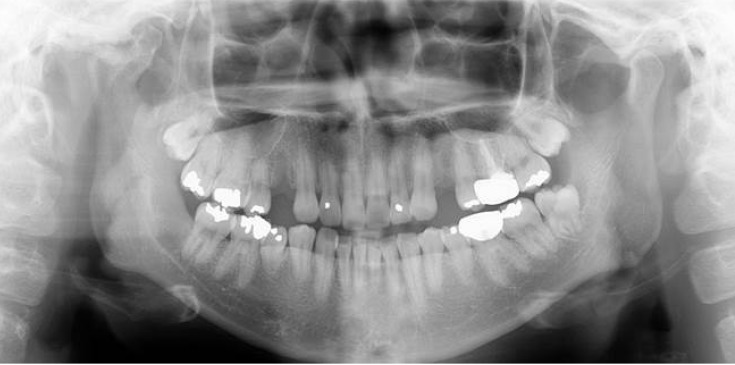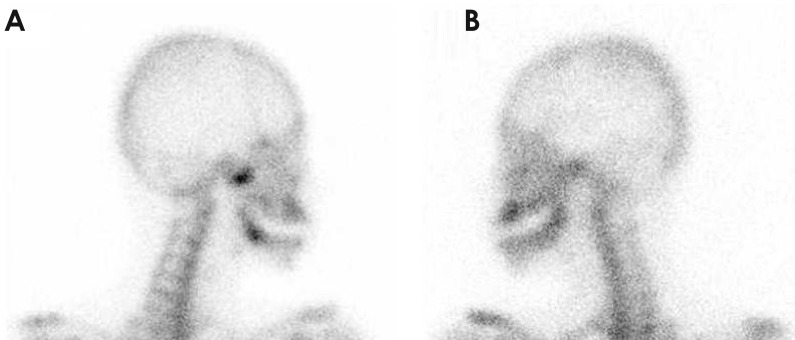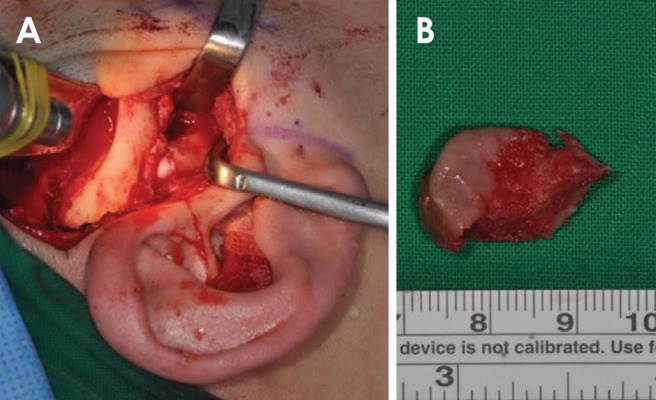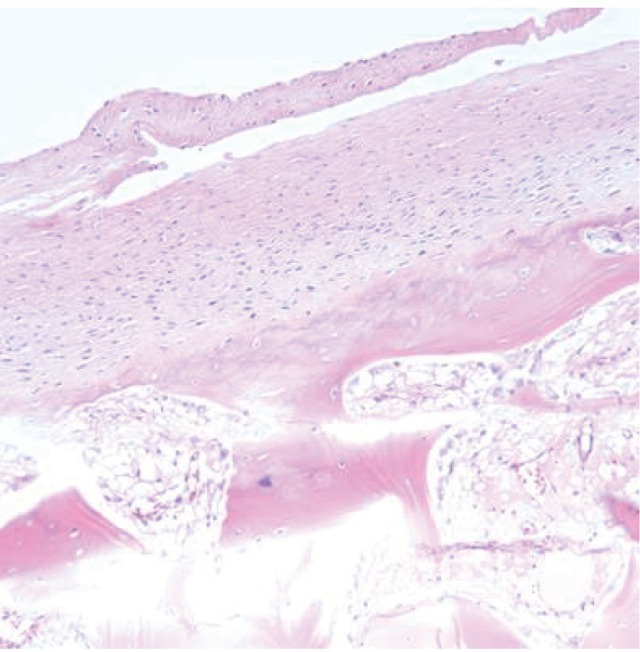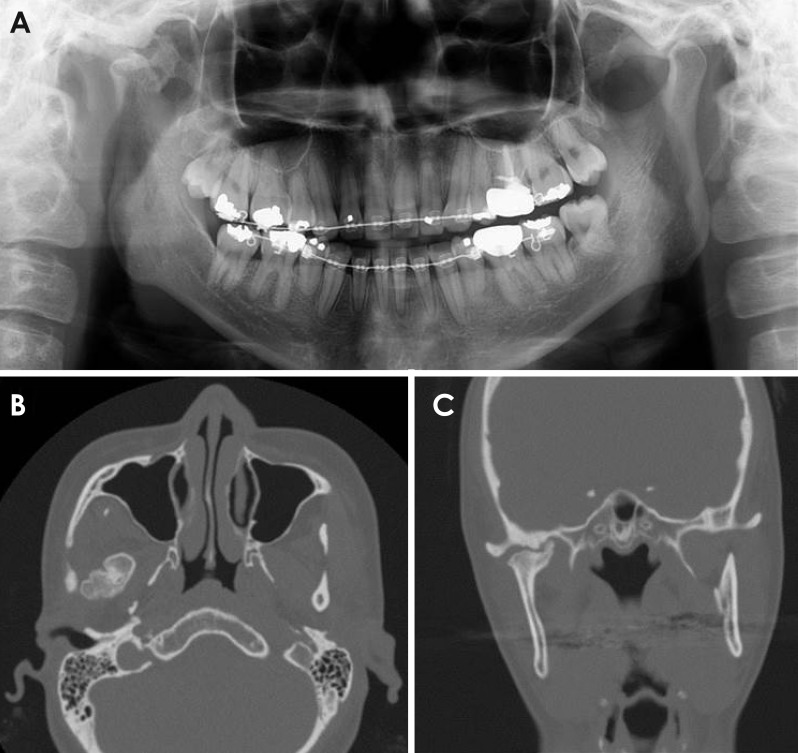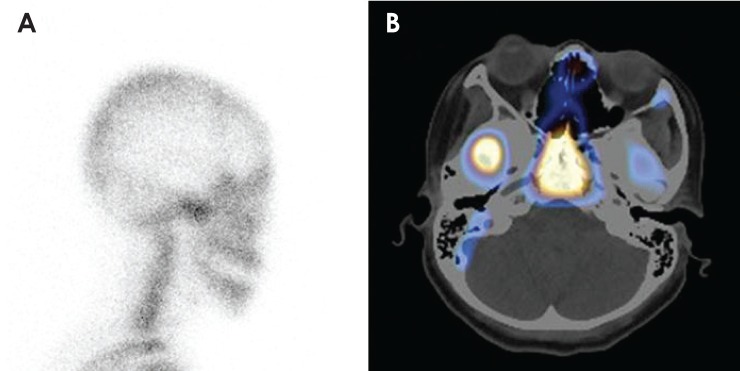Imaging Sci Dent.
2017 Mar;47(1):57-62. 10.5624/isd.2017.47.1.57.
Recurrent osteochondroma of the mandibular condyle: A case report
- Affiliations
-
- 1Department of Oral and Maxillofacial Radiology, School of Dentistry, Kyungpook National University, Daegu, Korea. syan@knu.ac.kr
- 2Department of Oral and Maxillofacial Surgery, School of Dentistry, Kyungpook National University, Daegu, Korea.
- 3Department of Oral and Maxillofacial Radiology, School of Dentistry, Chonnam National University, Gwangju, Korea.
- KMID: 2391408
- DOI: http://doi.org/10.5624/isd.2017.47.1.57
Abstract
- A 21-year-old woman presented with facial asymmetry. Crepitus and clicking of the temporomandibular joint were noted. The midline deviated 5.5 mm to the left, and secondary malocclusion was observed. Panoramic and cone-beam computed tomographic images showed an irregular and exophytic bony mass on the anteromedial surface of the right mandibular condyle. A 3-phase bone scan revealed increased tracer uptake on the affected side. The lesion was treated with excision and reshaping under the diagnosis of osteochondroma confirmed by a histopathological examination. The lesion recurred after 3 years, and the patient underwent condylectomy. Mandibular condylar osteochondroma is often resected because it causes functional and aesthetic problems, but it rarely recurs. To the best of our knowledge, only 2 cases of recurrent osteochondromas of the mandibular condyle have been reported previously. Surgical treatment of the osteochondroma should be performed considering the possibility of recurrence, and long-term follow-up is recommended.
MeSH Terms
Figure
Reference
-
1. Zhou Q, Yang C, Chen MJ. Osteochondroma of bilateral mandibular condyle: a case report. Int J Clin Exp Med. 2015; 8:2989–2992. PMID: 25932269.2. Karras SC, Wolford LM, Cottrell DA. Concurrent osteochondroma of the mandibular condyle and ipsilateral cranial base resulting in temporomandibular joint ankylosis: report of a case and review of the literature. J Oral Maxillofac Surg. 1996; 54:640–646. PMID: 8632254.3. Aydin MA, Küçükçelebi A, Sayilkan S, Celebioğlu S. Osteochondroma of the mandibular condyle: report of 2 cases treated with conservative surgery. J Oral Maxillofac Surg. 2001; 59:1082–1089. PMID: 11526583.4. Arora P, Deora SS, Kiran S, Bargale SD. Osteochondroma of condyle: case discussion and review of treatment modalities. BMJ Case Rep. 2014; 2014:pii: bcr2013200759.
Article5. Wolford LM, Mehra P, Franco P. Use of conservative condylectomy for treatment of osteochondroma of the mandibular condyle. J Oral Maxillofac Surg. 2002; 60:262–268. PMID: 11887135.
Article6. Vezeau PJ, Fridrich KL, Vincent SD. Osteochondroma of the mandibular condyle: literature review and report of two atypical cases. J Oral Maxillofac Surg. 1995; 53:954–963. PMID: 7629631.7. Peroz I. Osteochondroma of the condyle: case report with 15 years of follow-up. Int J Oral Maxillofac Surg. 2016; 45:1120–1122. PMID: 27156430.
Article8. Peroz I, Scholman H, Hell B. Osteochondroma of the mandibular condyle: a case report. Int J Oral Maxillofac Surg. 2002; 31:455–456. PMID: 12361086.
Article9. Zhang J, Wang H, Li X, Li W, Wu H, Miao J, et al. Osteochondromas of the mandibular condyle: variance in radiographic appearance on panoramic radiographs. Dentomaxillofac Radiol. 2008; 37:154–160. PMID: 18316507.
Article10. Avinash KR, Rajagopal KV, Ramakrishnaiah RH, Carnelio S, Mahmood NS. Computed tomographic features of mandibular osteochondroma. Dentomaxillofac Radiol. 2007; 36:434–436. PMID: 17881606.
Article11. Kondoh T, Seto K, Kobayashi K. Osteoma of the mandibular condyle: report of a case with a review of the literature. J Oral Maxillofac Surg. 1998; 56:972–979. PMID: 9710193.
Article12. Chandu A, Spencer JA, Dyson DP. Chondroma of the mandibular condyle: an example of a rare tumour. Dentomaxillofac Radiol. 1997; 26:242–245. PMID: 9442616.
Article13. Dhirawani RB, Anand K, Lalwani G, Pathak S, Thakkar B. True chondroma of the mandibular condyle: a rare case. Ann Maxillofac Surg. 2014; 4:220–223. PMID: 25593880.
Article
- Full Text Links
- Actions
-
Cited
- CITED
-
- Close
- Share
- Similar articles
-
- The Osteochondroma of the Mandibular Condyle: report of a case
- Surgical Treatment of Osteochondroma on the Mandibular Condyle through Intraoral Approach: Case Report
- Osteochonrdoma Of The Mandibular Condyle: A Case Report
- Conservative resection of osteochondroma on mandibular condyle: A case report
- Giant osteochondroma of the parapharyngeal space: a case report


